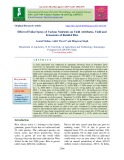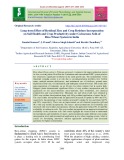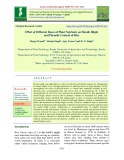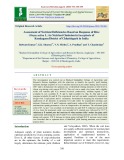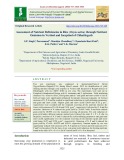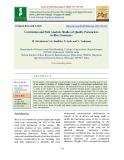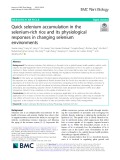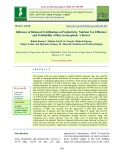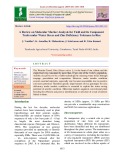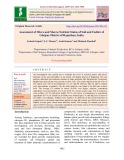
Nutrient deficiencies in rice
-
Effect of foliar spray of various nutrients on yield attributes, yield and economics of rainfed rice
A recent trend in the fertilizer industry to shift from ammonium sulphate to urea and from superphosphate to non-sulphur phosphatic fertilizer may induce more widespread sulphur deficiency in lowland rice. Keeping all above facts in view the present study was undertaken to find out the nutrient economy through foliar application of fertilizer and to assess the economic feasibility of various treatments.
 7p
7p  gaocaolon9
gaocaolon9
 22-12-2020
22-12-2020
 13
13
 1
1
 Download
Download
-
Rice-wheat (Oryza sativa L.-Triticum aestivum L.) rotation is the major production system in Asia, covering about 18 million ha. Continuous and conventional RWC system practice has witnessed a significant slowdown in the yield growth rate. The sustainability of this important cropping system is at risk due to second-generation problems (low fertility status, multiple nutrient deficiencies, and imbalanced use of fertilizers, ground water depletion at faster rate, soil salinization, and inadequate system diversity).
 14p
14p  nguaconbaynhay8
nguaconbaynhay8
 13-10-2020
13-10-2020
 16
16
 1
1
 Download
Download
-
Present study was undertaken to evolve an efficient and reliable measure for management of sheath blight of rice through application of judicious doses of plant nutrients. In this investigation, the effect of different doses i.e. control dose (naturally available in soil), deficient dose, recommended dose and excess dose of macronutrients (N, P &K) & micronutrients (S, Zn & Fe) were assessed on incubation period for first appearance of sheath blight, disease severity and on phenolic contents in inoculated rice plants.
 12p
12p  kethamoi7
kethamoi7
 26-08-2020
26-08-2020
 23
23
 2
2
 Download
Download
-
Agriculture is going through a profound revolution worldwide due to increasing world demand for food, higher costs of energy and other inputs, environmental pollution problems, and instability of cropping systems. The importance of plant functioning can be realized from the facts that knowledge of mineral nutrition of plants has opened new vistas for fertilizer practices. The detection of deficiencies and toxicity of particular mineral nutrient element has enabled us to make adequate soil amendments and root nutrient absorption for better plant growth.
 28p
28p  angicungduoc6
angicungduoc6
 20-07-2020
20-07-2020
 26
26
 2
2
 Download
Download
-
The investigation was carried out at Shaheed Gundadhur College of Agriculture and Research Station, Jagdalpur with the objectives to identify the specific yield limiting nutrients through response of rice to nutrient omission in pot culture during kharif season, 2017 and to demonstrate the optimum use of identified limiting nutrients at field level in wheat crop during rabi season 2017-18.
 10p
10p  trinhthamhodang1213
trinhthamhodang1213
 29-05-2020
29-05-2020
 9
9
 0
0
 Download
Download
-
Two pot experiment was conducted at Instructional Farm of Krishi Vigyan Kendra, Raigarh (C.G.) during Kharif season, 2015 for identification of yield limiting nutrients through crop response in Vertisol and Inceptisol of Raigarh district of Chhattisgarh with rice (MTU-1010) as test crop. The experiments were laid out in Completely Randomized Design with 11 treatments and 3 replications. Yield attributing characters viz. effective tillers, filled grains panicle-1 and grain and straw yields of rice in both soil types were significantly influenced by nutrient omission treatments.
 9p
9p  trinhthamhodang5
trinhthamhodang5
 16-05-2020
16-05-2020
 16
16
 1
1
 Download
Download
-
Development of micronutrient enriched staple foods is an important breeding goal in view of the extensive problem of ‘hidden hunger’ caused by micronutrient malnutrition. Iron and zinc are micronutrients essential to the human diet but are in deficient supply to many to many in the Tropics. In an effort to this problem through genetic improvement, field trials of Rice (60 Genotypes) were conducted at Jagtial during kharif 2014 to study the Association and path analysis.
 4p
4p  nguaconbaynhay5
nguaconbaynhay5
 16-05-2020
16-05-2020
 20
20
 1
1
 Download
Download
-
The element selenium (Se) deficiency is thought to be a global human health problem, which could disperse by daily-supplement from Se-rich food. Increasing the accumulation of Se in rice grain is an approach matched to these nutrient demands.
 11p
11p  viharuno2711
viharuno2711
 21-04-2020
21-04-2020
 12
12
 1
1
 Download
Download
-
Healthy seeds of different varieties of rice (PD 6, NDR 359, PD 16 and PS 5) and wheat (UP 262, UP 2628, PBW 175 and UP 2554) were germinated and fourteen days after germination, young rice/wheat seedlings were transferred to half strength of Hogland solution (pH 7.0) containing either recommended levels of Zn (0.05 mg Zn L-1 ) or no Zn for four days. For solidification of medium 0.4% w/v agar- agar was mixed in the Hogland solutions of both –Zn and +Zn. Prior to solidification, 11.25 mL of 0.1% bromothymol blue dye solution prepared in 60 % ethanol and was mixed to agar nutrient solution.
 6p
6p  chauchaungayxua3
chauchaungayxua3
 07-02-2020
07-02-2020
 6
6
 0
0
 Download
Download
-
The decline in the rice crop responses to applied fertilizer nutrients, inter alia, could be ascribed to emerging nutrient deficiencies on account of modern era of agriculture and inadequate or imbalanced application of fertilizers. It has become increasingly recognized around the world that N, P and K fertilizers alone are not always sufficient to provide balanced nutrition for optimal rice yields and quality, therefore, application of secondary and micronutrient elements has to be made.
 23p
23p  nguaconbaynhay3
nguaconbaynhay3
 07-02-2020
07-02-2020
 18
18
 2
2
 Download
Download
-
The Wonder Cereal, Rice (Oryza sativa L.) is the heart of our culture and the staple food crop consumed by more than 50 per cent of the world’s population. Aerobic rice proves to be a viable technology by reducing water losses through seepage, percolation and evaporation. However, under aerobic condition several essential nutrients, especially zinc became unavailable due to positive soil redox potential. Therefore genetic improvement of rice genotypes for zinc deficiency under aerobic condition is essential to exploit the water saving potential of aerobic condition.
 6p
6p  nguathienthan2
nguathienthan2
 19-12-2019
19-12-2019
 8
8
 0
0
 Download
Download
-
An investigation was carried out to estimate the level of selected macro and micronutrients in the soil and fodder of ten tehsils of Udaipur district of Rajasthan. The soil analysis indicated that moderate amount of major nutrients like Phosphorous, Potassium, Magnesium and calcium were present in these soils. This study indicated that the soils of this region were rich in micronutrients viz., Fe and Pb whereas, Mn, Cu and S contents were intermediate in quantity. On the other hand Zn was found to be deficient in these soils. The average Ca content in straws (0.
 9p
9p  kethamoi2
kethamoi2
 15-12-2019
15-12-2019
 12
12
 1
1
 Download
Download
CHỦ ĐỀ BẠN MUỐN TÌM









